| Article ID | Journal | Published Year | Pages | File Type |
|---|---|---|---|---|
| 1288388 | Journal of Power Sources | 2012 | 9 Pages |
A PEMFC stack inevitably experiences reverse current conditions during startup and shutdown processes. Residual oxygen partial pressure in the stack affects the local potential in the cathode facing oxygen in the anode and plays a critical role in cathode degradation. In this study, effects of residual oxygen partial pressure on PEMFC degradation were studied under reverse current conditions. Increasing the residual oxygen partial pressure under repetitive reverse current conditions accelerates performance decay and facilitates cathode degradation. Cathode degradation is revealed by an increase in charge-transfer resistance and a decrease in electrochemical active surface area, which can be attributed to corrosion of the carbon support and dissolution/migration and agglomeration of the platinum catalyst.
► Increasing the residual pO2pO2 under reverse current conditions accelerates performance decay. ► Cathode degradation was revealed by an increase in Rct and a decrease in EAS. ► It could be attributed to corrosion of carbon support. ► Moreover, it could be affected by dissolution/migration/agglomeration of Pt catalyst. ► To prevent the performance decay, pO2pO2 in the gas channel should be kept as low as possible.
